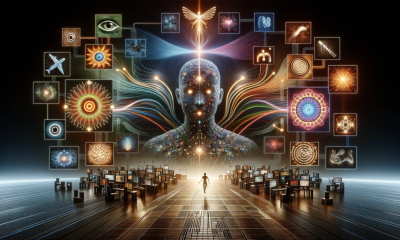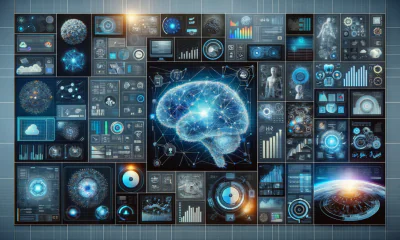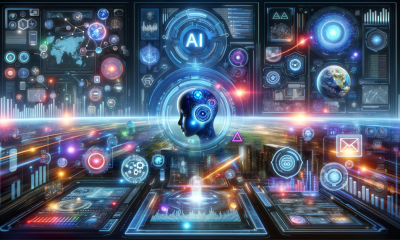Artificial Intelligence
From Static Slides to Smart Speeches: The Rise of AI-Powered Presentations

In the age of information overload, capturing and keeping an audience's attention is a challenge. Public speaking is undergoing a revolution, and at the forefront is artificial intelligence (AI). From crafting compelling content to analyzing delivery, AI is transforming the way we present information. This blog post dives into the exciting future of presentations, exploring how AI is empowering speakers to create impactful and engaging experiences for their audiences.
The Role of AI in Public Speaking
AI technology is becoming increasingly important in public speaking, revolutionizing how presentations are created, delivered, and received. With AI tools, speakers can simplify content creation by generating insightful narratives and creating visually appealing slides using AI presentation makers. These platforms also offer personalized coaching and feedback, helping speakers refine their delivery style and engage audiences better.
Additionally, real-time language translation tools powered by AI are making it easier to communicate with diverse audiences worldwide. As AI continues to advance, its integration into public speaking promises to enhance the quality and effectiveness of presentations, promoting better communication and understanding among audiences.
How AI Helps Users in Public Speaking
1. Streamline Research and Content Creation
In November 2022, OpenAI launched ChatGPT (Chat Generative Pre-trained Transformer), an AI-driven chatbot capable of answering questions, writing essays and poems, and more.
ChatGPT is a versatile tool that can be used for both fun and productivity. You can use it to brainstorm ideas, conduct research, and create speech content. For example, if you ask it a question like “Why are some people afraid of artificial intelligence? Can you define artificial intelligence and give examples from history and pop culture?”, ChatGPT can quickly provide three reasons along with examples and references.
Think of ChatGPT as your personal mentor that you can turn to for answers. It's helpful for learning about topics in a way that's different from reading a textbook. If something isn't clear, you can ask ChatGPT to explain it further.
However, it's important to remember that ChatGPT isn't perfect. It's about 85% accurate, so sometimes its responses may not be entirely accurate. Also, its knowledge is limited to the most recent data it's been trained on. Despite this, chatbots like ChatGPT and Gemini can easily help you to streamline your research and content creation.
2. Designing Professional Slides
You might already have access to tools that can help you design polished slides quickly. Canva's Magic Design feature uses AI to generate various template designs for multi-slide presentations with just one prompt. Another option is SlidesAI, which is a versatile tool that assists in converting text to PowerPoint presentations within minutes. It also offers design assistance and a wide range of customization options to ensure your presentations look professional when presenting to an audience.
3. Creating Unique Images
Instead of spending hours searching for or designing images, consider using an image generator like DALL-E. This tool quickly creates images based on custom prompts, addressing the specific points you want to highlight in your presentation. This saves time and ensures the creation of unique, relevant images that are also royalty-free.
Illustrative Examples:
For example, you could prompt DALL-E to create an image of a couple holding hands while scuba diving among colorful tropical fish, similar to scenes from the Avatar movies.
Similarly, you could request an oil painting-style depiction of the Earth seen from space, with the sun rising behind it, inspired by the artistic style of Vincent van Gogh.
4. Get Feedback on Your Speech
AI is revolutionizing public speaking practice by offering a virtual coach that provides insightful feedback beyond the limitations of self-recording. Unlike simply watching yourself back, AI can analyze your speech patterns, offering real-time data on elements like pacing, filler words, and vocal variety. This allows you to identify areas where you might be speaking too quickly, relying on crutches like “um” and “uh,” or failing to modulate your voice for emphasis.
AI can even analyze your eye contact patterns, highlighting sections where you might be disengaged from the audience. This objective analysis, delivered immediately after your practice session, allows you to focus on specific aspects for improvement. With each iteration, AI helps you refine your delivery, ensuring your message is clear, engaging, and leaves a lasting impact on your audience.
Closing Thoughts
AI tools can greatly aid in creating and improving presentations, making the process more efficient and enjoyable. Experimenting with new software options can be a rewarding experience.
Nevertheless, it's essential to recognize that AI tools are most beneficial when used alongside individualized training, feedback, and coaching from an experienced business presentation skills coach.
Above all, keep in mind the importance of the audience. No matter how flashy the visuals or effects, a presentation's success hinges on its relevance and connection with the audience.














